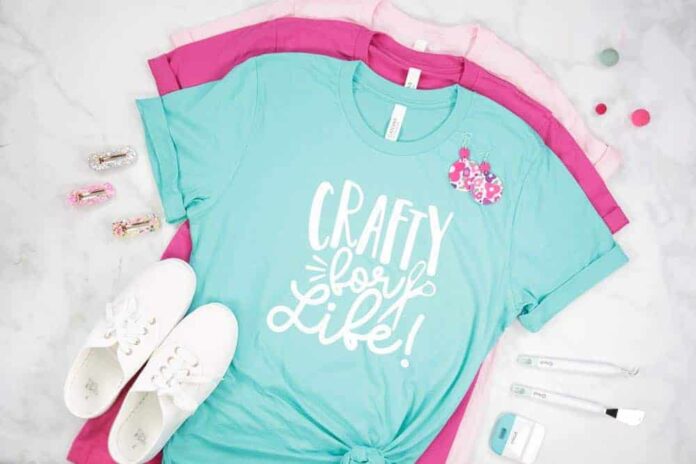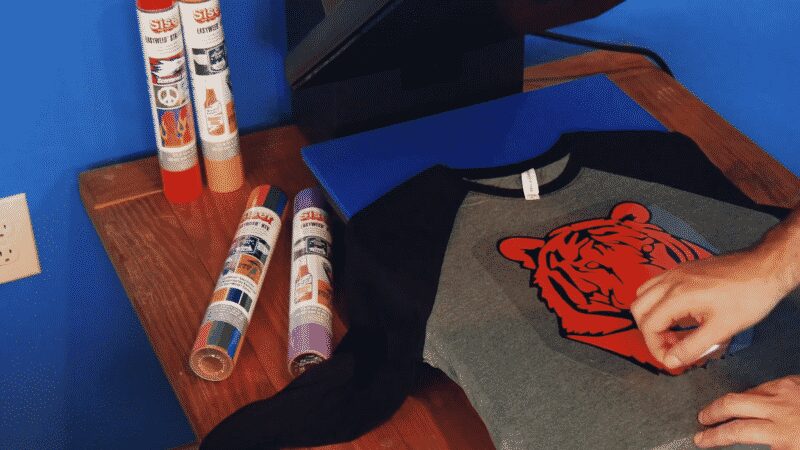Vinyl is one of the most popular crafting materials. It is suitable for all kinds of projects. For example, you can use it for shirts, hats, etc. However, iron-on vinyl requires a little more dedication. Although vinyl is easy to work with, there are a few modifications you need to know that will make it look even better. In this way, the entire project will turn out exactly as you wanted. We will try to provide you with as much useful information as possible when it comes to working with vinyl.
What is Iron on Vinyl?
Iron-on vinyl is a material that is stretched, cut and heated. This is exactly what the whole process of working with this type of vinyl looks like. The goal is to permanently transfer content to another material. Keep in mind that different products require different settings for temperature, time, cutting process and everything else.
So, you can use this material for different purposes. It is a special type that is thermally activated with glue. The type of material includes fabric, metal, paper, as well as wood. If you’re new to vinyl, you’re probably wondering what the difference is between iron-on vinyl and heat transfer vinyl. Don’t let things like this confuse you, because there is no difference. They are just two different names for the same thing. It all depends on how the brands will use it, but it’s the same material. You can learn more at www.htvront.com about iron on vinyl since there is much more to know and we can’t cover everything in just one paragraph, but we have to continue and explain other things as well.
Types of Iron on Vinyl
So that you don’t have to try every type of iron-on vinyl, we have separated the types and their characteristics. That way, you’ll understand what makes certain types unique and great. Everyday Iron-on is the material we recommend for beginners. One of the many advantages is that there is a wide variety of colors and other options. For example, you can use it as the first layer, and put some other type of heat transfer material over it. Versatility is not the only advantage, it is also durable. However, try to follow the manufacturer’s instructions so that you can use it as long as possible. Unlike the previous material, SportFlex iron-on cannot be layered. Don’t worry, it’s not difficult to use it, but be careful. This means that you will think carefully about your design beforehand. You can wash it a lot of times, but don’t use the warm pilling technique in this case. When you want to access an abundance of creative possibilities then use patterned iron-on. With it, you will be able to realize various trendy patterns.
However, do not use it as a base layer but add it on top of other ironing material. It can also be one pattern iron on, and then another layer of the same on top of that. It is used in combination with a cold peel, wait for it to cool before you start peeling. A few minutes are enough. When you want to achieve a shiny look, use glitter iron-on. It is used to create products that have a touch of glamor and brashness. For example, it will perform perfectly during the creation of costumes for Halloween and similar events. That’s why it’s important to think carefully about the project before you buy the material and start building. If you decide to work with this type of iron on vinyl, use the hot peel technique.
Applying a second layer over glitter iron on is not recommended. When we talk about shine, we must not forget about holographic iron-on. It is similar to the previous type of vinyl, and is a popular choice when creating stylish party wear or home decor. Iron-on foil is another popular material, and is a great option for party decorations. The main reason is its reflective surface.
How Do I Get the Best Results?

In order to achieve outstanding results, you need to pay attention to several important factors. Consider the specificity of vinyl. Do not ignore the manufacturer’s instructions, especially if you are dealing with a particular type of iron-on vinyl for the first time. If you want to be sure you’re doing the right thing, always try a test cut before starting the job. Based on the test, you can expect the best possible results. It is recommended that you cut slowly in order to do this accurately. This is especially true of the thinnest vinyl, as it is cut at high speed. If you want to create a multi-layered vinyl design, you need more material. However, this does not mean that you will randomly arrange the layers.
You have to do it in the correct order. Otherwise you will get bubbles and waves. One good strategy is regular ironing over regular ironing. You can also put a basic ironing and a special design on top or vice versa. The next important item is the brand you use. If you want a quality product, you have to think about every step of the process. Find vinyl that is easy to work with. Get all the supplies and tools you need. It is basic material like shirt, machine, fine point blade etc. Next, prepare the fabric to remove all dirt and chemicals from it. Such things can interfere with adhesion. Cut carefully and think carefully about the design.
If necessary, adjust the size of the design and click the make it button. Use gentle pressure when cutting. Remove the excess vinyl with the tool and be gentle. Sometimes it is necessary to use more than one tool. Double-check your work to make sure you’ve removed all excess material. Now comes the preparation for applying iron-on vinyl. Set up the work area, protect it and heat the device. The temperature depends on the type of vanilla and the material. Make sure to smooth out any wrinkles in the fabric and lay it flat. Apply the vinyl to the base material, then apply heat to it. Turn the item over and apply heat to the other side. When cool, peel off the plastic layer.
Conclusion:

Although you can do the same job well either way, we recommend using iron-on vinyl for several reasons. First of all, iron-on is a better choice if you are working with fabric. Thanks to its features, you can forget about damaging the material. Standard vinyl stays on the fabric for a much shorter time. Iron-on also withstands machine washing unlike its adhesive counterpart.









